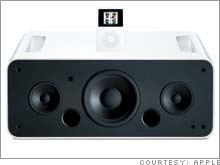|
Sonic Boom: The iPod Goes Hi-Fi
Apple takes on digital stereo with a new speaker dock--and it rocks.
(FORTUNE Magazine) - Apple has sold more than 42 million iPod portable digital music players, and more than a billion legally downloaded songs. Legions of music zombies wander the streets with white wires dangling from their ears. In the home, pocket-sized iPods are replacing audio CD players and stacks of discs. At this point, even audiophiles have to accept that this digital music thing is probably more than just a passing fad.
And to remove any lingering doubt, Apple (Research) has now designed a speaker system especially for the iPod and the digital music age. The iPod Hi-Fi ($349) essentially replaces the remaining half of the old-fashioned audio CD stereo system, producing room-filling sound from an enclosure the size of a shoebox. Well, okay, a shoebox for someone with Bozo-sized feet. But still, at 17 inches wide, seven inches deep, and less than seven inches tall, it's ideal for kitchens, bedrooms, or other places where you desire big sound from a small package. Even with an iPod standing in the connection dock on top, the Hi-Fi fits easily under a 12-inch shelf. The classic iPod-white box has a black face and a removable black grill, which lends unobtrusive elegance to any room while also appeasing folks who favor ebony iPod models. The grill covers a pair of 2.5-inch drivers and a four-inch woofer. The Hi-Fi comes with adapters for all iPod models that have dock connectors. (Although it was designed specifically as an iPod accessory, the Hi-Fi will work with almost any portable MP3 player, just not as elegantly. To connect a non-Apple player, or the dinky iPod Shuffle, you'll need to buy a 3.5-millimeter audio stereo cable--about $13.) A standard AC power cord trails from behind -- it also charges the iPod's internal battery when docked -- and there are just two buttons: + and -. Other sound controls are handled through the iPod menu system. A miniature remote control allows the Hi-Fi to be operated from a distance limited primarily by the user's ability to see the iPod control screen from across the room. The remote is handy for turning the iPod Hi-Fi on and off, adjusting volume, skipping songs, pausing, and other basic tasks. (The remote also has a button called MENU, but it does not appear to have any useful role.) Just as the iPod is designed to allow the owner to take music anywhere, so too is the Hi-Fi. It switches easily to DC power, using six D-cell batteries (not included), and has sturdy, recessed handles. But at 16-plus pounds, it is more suitable for lugging room to room than to the park or the beach. Apple claims that the iPod Hi-Fi delivers audiophile-quality sound, the kind of audacious claim that causes true audiophiles to sizzle and hiss and pop like so many overly excited vacuum tubes. Even casual music buffs will be able to hear the system's relative deficiencies. Would I replace my better-than-average home stereo with an iPod Hi-Fi? No way; I'd just patch my iPod into the receiver. Nor would I replace the Logitech surround-sound computer speakers through which I do most of my digital music listening, even though the Hi-Fi connects to any computer through analog or digital audio cables. I did, however, compare the iPod Hi-Fi with a Bose SoundDock music system ($299), which delivered what I considered until now the best sound of any of the iPod-centric, semi-portable speaker docks on the market. Apple's iPod Hi-Fi is worth the extra $50, no question. It richly fills the gap between earbuds and high-end stereo systems.
For many iPod owners, including dorm denizens and nomads weary of schlepping stereo systems from crib to crib, the iPod Hi-Fi could be the best speaker of the house. |
|

